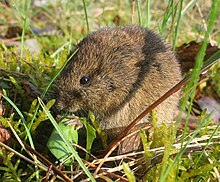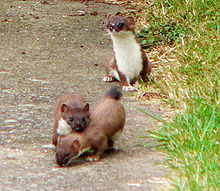List of mammals of Romania
The Eurasian lynx is the national animal of Romania. There are ninety mammal species in Romania , of which one is critically endangered , one is endangered, fourteen are vulnerable, and four are near threatened.[ 1]
The following tags are used to highlight each species' conservation status as assessed by the International Union for Conservation of Nature :
EX
Extinct No reasonable doubt that the last individual has died.
EW
Extinct in the wild Known only to survive in captivity or as a naturalized populations well outside its previous range.
CR
Critically endangered The species is in imminent risk of extinction in the wild.
EN
Endangered The species is facing an extremely high risk of extinction in the wild.
VU
Vulnerable The species is facing a high risk of extinction in the wild.
NT
Near threatened The species does not meet any of the criteria that would categorise it as risking extinction but it is likely to do so in the future.
LC
Least concern There are no current identifiable risks to the species.
DD
Data deficient There is inadequate information to make an assessment of the risks to this species.
Northern birch mouse European hamster Common vole Rodents make up the largest order of mammals, with over 40% of mammalian species. They have two incisors in the upper and lower jaw which grow continually and must be kept short by gnawing. Most rodents are small though the capybara can weigh up to 45 kg (99 lb).
European hare The lagomorphs comprise two families, Leporidae (hares and rabbits ), and Ochotonidae (pikas ). Though they can resemble rodents , and were classified as a superfamily in that order until the early twentieth century, they have since been considered a separate order. They differ from rodents in a number of physical characteristics, such as having four incisors in the upper jaw rather than two.
The order Erinaceomorpha contains a single family, Erinaceidae, which comprise the hedgehogs and gymnures . The hedgehogs are easily recognised by their spines while gymnures look more like large rats.
Lesser white-toothed shrew Eurasian water shrew Common shrew European mole Shrews are insectivorous mammals. They closely resemble mice while the moles are stout-bodied burrowers.
Daubenton's bat Serotine bat Lesser noctule Nathusius' pipistrelle The bats' most distinguishing feature is that their forelimbs are developed as wings, making them the only mammals capable of flight. Bat species account for about 20% of all mammals.
Harbour porpoise The order Cetacea includes whales , dolphins and porpoises . They are the mammals most fully adapted to aquatic life with a spindle-shaped nearly hairless body, protected by a thick layer of blubber, and forelimbs and tail modified to provide propulsion underwater.
Red fox Stoat There are over 260 species of carnivorans, the majority of which feed primarily on meat. They have a characteristic skull shape and dentition.
Chamois The even-toed ungulates are ungulates whose weight is borne about equally by the third and fourth toes, rather than mostly or entirely by the third as in perissodactyls . There are about 220 artiodactyl species, including many that are of great economic importance to humans.
Locally extinct
The following species are locally extinct in the country:
See also
References
^ This list is derived from the IUCN Red List which lists species of mammals and includes those mammals that have recently been classified as extinct (since 1500 AD). The taxonomy and naming of the individual species is based on those used in existing Wikipedia articles as of 21 May 2007 and supplemented by the common names and taxonomy from the IUCN, Smithsonian Institution, or University of Michigan where no Wikipedia article was available.
^ Amori, G.; Hutterer, R.; Kryštufek, B.; Yigit, N.; Mitsain, G. & Muñoz, L. J. P. (2010). "Sciurus vulgaris " . IUCN Red List of Threatened Species 2010 : e.T20025A9136220. ^ Bertolino, S.; Amori, G.; Henttonen, H.; Zagorodnyuk, I.; Zima, J.; Juškaitis, R.; Meinig, H. & Kryštufek, B. (2008). "Eliomys quercinus " . IUCN Red List of Threatened Species 2008 : e.T7618A12835766. ^ Batsaikhan, N.; Henttonen, H.; Meinig, H.; Shenbrot, G.; Bukhnikashvili, A.; Hutterer, R.; Kryštufek, B.; Yigit, N.; Mitsain, G. & Palomo, L. (2016). "Arvicola amphibius " . IUCN Red List of Threatened Species 2016 : e.T2149A115060819. ^ Hacklande, K. & Schai-Braun, S. (2019). "Lepus europaeus " . IUCN Red List of Threatened Species 2019 : e.T41280A45187424. ^ Villafuerte, R. & Delibes-Mateos, M. (2019). "Oryctolagus cuniculus " . IUCN Red List of Threatened Species 2019 : e.T41291A45189779. ^ Amori, G.; Hutterer, R.; Kryštufek, B.; Yigit, N.; Mitsain, G. & Palomo, L.J. (2016). "Erinaceus roumanicus " . IUCN Red List of Threatened Species 2016 : e.T136344A115206348. ^ Hutterer, R.; Amori, G.; Krystufek, B.; Yigit, N.; Mitsain, G. & Palomo, L.J. (2010). "Crocidura suaveolens " . IUCN Red List of Threatened Species 2010 : e.T29656A9511068. ^ Paunović, M. (2019). "Myotis bechsteinii " . IUCN Red List of Threatened Species 2019 : e.T14123A22053752. ^ Juste, J. & Paunović, M. (2016). "Myotis blythii " . IUCN Red List of Threatened Species 2016 : e.T14124A22053297. ^ Gazaryan, S.; Kruskop, S.V. & Godlevska, L. (2020). "Myotis brandtii " . IUCN Red List of Threatened Species 2020 : e.T85566997A22054468. ^ Hutson, A. M.; Spitzenberger, F.; Aulagnier, S.; Juste, J.; Karatas, A.; Palmeirim, J. & Paunovic, M. (2010). "Myotis capaccinii " . IUCN Red List of Threatened Species 2010 : e.T14126A4399043. ^ Kruskop, S.V.; Godlevska, L.; Bücs, S.; Çoraman, E. & Gazaryan, S. (2020). "Myotis daubentonii " . IUCN Red List of Threatened Species 2020 : e.T85342710A22054773. ^ Piraccini, R. (2016). "Myotis emarginatus " . IUCN Red List of Threatened Species 2016 : e.T14129A22051191. ^ Coroiu, I.; Juste, J. & Paunović, M. (2016). "Myotis myotis " . IUCN Red List of Threatened Species 2016 : e.T14133A22051759. ^ Gazaryan, S.; Kruskop, S.V. & Godlevska, L. (2020). "Myotis nattereri " . IUCN Red List of Threatened Species 2020 : e.T85733032A22052584. ^ Piraccini, R. (2016). "Barbastella barbastellus " . IUCN Red List of Threatened Species 2016 : e.T2553A22029285. ^ Hutson, A. M.; Alcaldé, J. T.; Juste, J.; Karataş, A.; Palmeirim, J. & Paunović, M. (2010). "Nyctalus lasiopterus " . IUCN Red List of Threatened Species 2010 : e.T14918A4471682. ^ Juste, J. & Paunović, M. (2016). "Nyctalus leisleri " . IUCN Red List of Threatened Species 2016 : e.T14919A22016159. ^ Csorba, G. & Hutson, A.M. (2016). "Nyctalus noctula " . IUCN Red List of Threatened Species 2016 : e.T14920A22015682. ^ Hutson, A. M.; Spitzenberger, F.; Juste, J.; Aulagnier, S.; Palmeirim, J.; Karatas, A. & Paunovic, M. (2010). "Pipistrellus nathusii " . IUCN Red List of Threatened Species 2010 : e.T17316A6966886. ^ Gazaryan, S.; Kruskop, S.V. & Godlevska, L. (2021) [errata version of 2020 assessment]. "Plecotus auritus " . IUCN Red List of Threatened Species 2020 : e.T85535522A195861341. ^ Gazaryan, S.; Bücs, S. & Çoraman, E. (2021) [errata version of 2020 assessment]. "Miniopterus schreibersii " . IUCN Red List of Threatened Species 2020 : e.T81633057A19585652. ^ Taylor, P. (2016). "Rhinolophus blasii " . IUCN Red List of Threatened Species 2016 : e.T19515A21972073. ^ Juste, J. & Alcaldé, J. (2016). "Rhinolophus euryale " . IUCN Red List of Threatened Species 2016 : e.T19516A21971185. ^ Piraccini, R. (2016). "Rhinolophus ferrumequinum " . IUCN Red List of Threatened Species 2016 : e.T19517A21973253. ^ Taylor, P. (2016). "Rhinolophus hipposideros " . IUCN Red List of Threatened Species 2016 : e.T19518A21972794. ^ Alcaldé, J.; Benda, P. & Juste, J. (2016). "Rhinolophus mehelyi " . IUCN Red List of Threatened Species 2016 : e.T19519A21974380. ^ Braulik, G.; Jefferson, T.A. & Bearzi, G. (2021). "Delphinus delphis " . IUCN Red List of Threatened Species 2021 : e.T134817215A50352620. ^ Gerngross, P.; Ambarli, H.; Angelici, F.M.; Anile, S.; Campbell, R.; Ferreras de Andres, P.; Gil-Sanchez, J.M.; Götz, M.; Jerosch, S.; Mengüllüoglu, D.; Monterosso, P. & Zlatanova, D. (2022). "Felis silvestris " . IUCN Red List of Threatened Species 2022 : e.T181049859A181050999. doi :10.2305/IUCN.UK.2022-1.RLTS.T181049859A181050999.en . Retrieved 3 August 2022 . ^ Breitenmoser, U.; Breitenmoser-Würsten, C.; Lanz, T.; von Arx, M.; Antonevich, A.; Bao, W. & Avgan, B. (2015). "Lynx lynx " . IUCN Red List of Threatened Species 2015 : e.T12519A121707666. ^ Hoffmann, M.; Arnold, J.; Duckworth, J. W.; Jhala , Y.; Kamler, J. F. & Krofel, M. (2018). "Canis aureus " . IUCN Red List of Threatened Species 2018 : e.T118264161A46194820. ^ Boitani, L.; Phillips, M. & Jhala , Y. (2018). "Canis lupus " . IUCN Red List of Threatened Species 2018 : e.T3746A119623865. ^ Kauhala, K. & Saeki, M. (2016). "Nyctereutes procyonoides " . IUCN Red List of Threatened Species 2016 : e.T14925A85658776. ^ Hoffmann, M. & Sillero-Zubiri, C. (2016). "Vulpes vulpes " . IUCN Red List of Threatened Species 2016 : e.T23062A46190249. ^ McLellan, B. N.; Proctor, M. F.; Huber, D. & Michel, S. (2017). "Ursus arctos " . IUCN Red List of Threatened Species 2017 : e.T41688A121229971. ^ Roos, A.; Loy, A.; de Silva, P.; Hajkova, P. & Zemanová, B. (2015). "Lutra lutra " . IUCN Red List of Threatened Species 2015 : e.T12419A21935287. ^ Abramov, A.V.; Kranz, A.; Herrero, J.; Krantz, A.; Choudhury, A. & Maran, T. (2016). "Martes foina " . IUCN Red List of Threatened Species 2016 : e.T29672A45202514. ^ Herrero, J.; Kranz, A.; Skumatov, D.; Abramov, A.V.; Maran, T. & Monakhov, V.G. (2016). "Martes martes " . IUCN Red List of Threatened Species 2016 : e.T12848A45199169. ^ Kranz, A.; Abramov, A. V.; Herrero, J. & Maran, T. (2016). "Meles meles " . IUCN Red List of Threatened Species 2016 : e.T29673A45203002. ^ Reid, F.; Helgen, K. & Kranz, A. (2016). "Mustela erminea " . IUCN Red List of Threatened Species 2016 : e.T29674A45203335. ^ Maran, T.; Aulagnier, S.; Libois, R.; Kranz, A.; Abramov, A. & Wozencraft, C. (2010). "Mustela lutreola " . IUCN Red List of Threatened Species 2010 : e.T14018A4381596. ^ McDonald, R. A.; Abramov, A. V.; Stubbe, M.; Herrero, J.; Maran, T.; Tikhonov, A.; Cavallini, P.; Kranz, A.; Giannatos, G.; Kryštufek, B. & Reid, F. (2019). "Mustela nivalis" . IUCN Red List of Threatened Species 2019 : e.T70207409A147993366. ^ Skumatov, D.; Abramov, A.V.; Herrero, J.; Kitchener, A.; Maran, T.; Kranz, A.; Sándor, A.; Stubbe, M.; Saveljev, A.; Savour-Soubelet, A.; Guinot-Ghestem, M.; Zuberogoitia, I.; Birks, J.D.S.; Weber, A.; Melisch, R. & Ruette, S. (2016). "Mustela putorius " . IUCN Red List of Threatened Species 2016 : e.T41658A45214384. ^ Reid, F.; Schiaffini, M. & Schipper, J. (2016). "Neovison vison " . IUCN Red List of Threatened Species 2016 : e.T41661A45214988. ^ Abramov, A.V.; Kranz, A. & Maran, T. (2016). "Vormela peregusna " . IUCN Red List of Threatened Species 2016 : e.T29680A45203971. ^ Plumb, G.; Kowalczyk, R. & Hernandez-Blanco, J.A. (2020). "Bison bonasus " . IUCN Red List of Threatened Species 2020 : e.T2814A45156279. ^ Aulagnier, S.; Giannatos, G. & Herrero, J. (2008). "Rupicapra rupicapra " . IUCN Red List of Threatened Species 2008 : e.T39255A10179647. ^ Lovari, S.; Lorenzini, R.; Masseti, M.; Pereladova, O.; Carden, R.F.; Brook, S.M. & Mattioli, S. (2018). "Cervus elaphus " . IUCN Red List of Threatened Species 2018 : e.T55997072A142404453. ^ Masseti, M. & Mertzanidou, D. (2008). "Dama dama " . IUCN Red List of Threatened Species 2008 : e.T42188A10656554. ^ Lovari, S.; Herrero, J.; Masseti, M.; Ambarli, H.; Lorenzini, R. & Giannatos, G. (2016). "Capreolus capreolus " . IUCN Red List of Threatened Species 2016 : e.T42395A22161386. ^ Keuling, O. & Leus, K. (2019). "Sus scrofa " . IUCN Red List of Threatened Species 2019 : e.T41775A44141833. ^ Karamanlidis, A. & Dendrinos, P. (2015). "Monachus monachus " . IUCN Red List of Threatened Species 2015 : e.T13653A45227543.
External links
Sovereign states States with limited Dependencies and
















